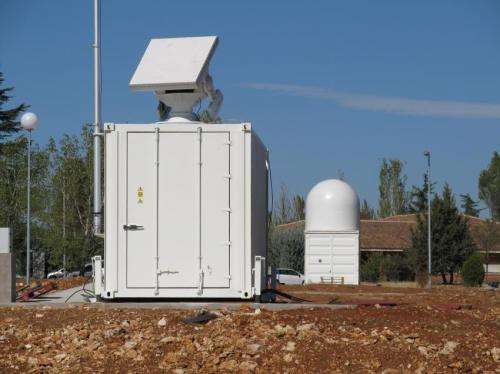ESA deploys first orbital debris test radar in Spain

(Phys.org)—A new radar designed to test methods for finding orbital debris that can be hazardous to space navigation has been installed in Spain. The radar will be used to develop future debris warning services, helping boost safety for European satellite operators.
Following an 18-month design and development phase, the radar was installed near Santorcaz, about 30 km from Madrid, and the first series of acceptance and validation tests are scheduled to begin in mid-November.
ESA's Space Situational Awareness (SSA) programme office and Spain's Indra Espacio S.A. signed a €4.7-million contract to build the radar in 2010.
Early debris detection is crucial to help warn satellite operators of collision risks and enable avoidance manoeuvres to be made.
Indra Espacio is the prime industrial partner and is responsible for the design and development of the radar transmitter. The development of the radar receiver was subcontracted to the Fraunhofer Institute for High Frequency Physics and Radar Techniques (FHR), Wachtberg, Germany.
Significant milestone in ESA's SSA programme
"Installation of the test radar at Santorcaz is a significant milestone in ESA's SSA programme," says Nicolas Bobrinsky, Head of ESA's Space Situational Awareness Preparatory Programme.
"Fielding a so-called 'breadboard' radar means that Spanish and German industry are developing world-class technical expertise in the radar detection of hazardous space debris."
'Breadboard' means that the radar is easily reconfigurable depending on test results, helping engineers optimise its performance over time.
Test radar uses 'monostatic' design to detect debris
The radar deployed in Spain by ESA makes use of the 'monostatic' design, in which the transmitter and receiver are co-located within just a few hundred meters.
A second contract to develop a 'bistatic' design radar, in which the transmitter and receiver are separated by several hundreds of kilometres, was signed with a separate industrial grouping in September 2012.
"This monostatic radar will be used to demonstrate and validate radar technologies for space debris surveillance in low-altitude orbits," says Gian Maria Pinna, Ground Segment Manager in ESA's SSA office.
"Although the capabilities of the test radar are limited, its design will allow us to achieve considerable understanding of the technical problems inherent in orbital debris detection with radar techniques, a know-how that ESA is increasingly building-up via the SSA Programme."
In the future, the two test radars, bistatic and monostatic, will be joined by an initial set of optical telescopes for the surveillance of higher altitude orbits, and the entire system will be incrementally improved to develop precursor warning services for satellite operators.
Provided by European Space Agency




















